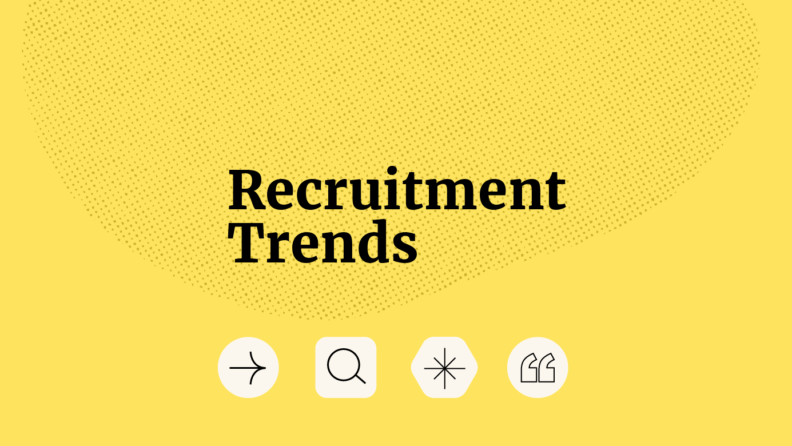Staying on top of recruitment trends is essential if you want to attract top talent and stay competitive. By understanding these trends, you can enhance your strategies and improve your hiring outcomes. Whether you're in tech, healthcare, or retail, knowing the latest in recruitment trends can make all the difference for sourcing and hiring the best talent.
Top 7 Most Impactful Recruitment Trends in 2025
Here's a curated, up-to-date roundup of the most important trends in the recruitment field for 2025. From AI-driven candidate engagement to strategic recruitment marketing, these trends are reshaping how you approach recruitment. Let's dive into each trend:
1. AI-Driven Candidate Engagement
The rise of AI-powered recruitment tools is transforming how recruiting teams approach candidate engagement, with 51% of organizations using AI to support recruiting efforts, according to SHRM. By automating routine tasks and personalizing communication, this technology allows HR professionals to focus on more strategic aspects like developing career paths for open roles and coming up with thoughtful interview questions.
For example, AI chatbots can engage candidates with personalized messages, keeping them informed throughout the hiring process. These tools also support resume parsing, drafting job descriptions, and even onboarding new hires. Meanwhile, recruiters can work on their hiring strategy.
These practices help you maximize AI in your recruitment efforts:
- Automate Initial Outreach: Use AI chatbots to engage candidates right from the application stage, ensuring timely responses and maintaining interest.
- Personalize Communication: Tailor follow-up emails and messages based on candidate behavior and feedback to improve engagement.
- Leverage Predictive Analytics: Use AI to predict candidate fit and success based on historical data, aiding in more informed hiring decisions.
2. Video Interview Technologies
Video interviewing has become the norm, especially in remote work settings. The platforms that support video interviews enable recruitment teams to evaluate candidates through recorded or live video sessions. With advancements in AI, video platforms (and even some free recruiting tools) now offer features like automated scheduling, real-time feedback, and integrated evaluation metrics, making it easier for hiring managers to assess candidates.
Increasingly, these tools are incorporating more AI-driven features, offering capabilities like automatic transcription and emotion analysis to better assess candidates. As the use of video interviews grows, recruiters can expect more integration with other human resources tools, allowing for a smoother employee experience from recruitment through to retention.
To optimize your use of video interview technologies, consider these tips:
- Use Structured Interview Guides: Implement standard questions and evaluation criteria to ensure consistency across all video interviews.
- Incorporate Real-Time Feedback: Allow team members to provide immediate input during live interviews to enhance decision-making.
- Ensure Technical Readiness: Test video platforms beforehand to avoid technical glitches and ensure smooth candidate interactions.
3. Strategic Recruitment Marketing
Strategic recruitment marketing is about using marketing tactics to attract and engage potential candidates, positioning your organization as an employer of choice. It focuses on building a strong employer brand and using targeted campaigns to reach desired talent pools. In 2025, this approach is increasingly data-driven, leveraging analytics to refine recruitment strategies and ensure effective communication with potential hires.
Recruiters use programmatic advertising, personalized communications, and advanced analytics to predict hiring success and tailor campaigns to specific demographics. As media strategies diversify, platforms like TikTok and Reddit become essential for reaching varied talent pools.
These strategies can enhance your recruitment marketing efforts:
- Leverage AI and Analytics: Use AI-driven tools to predict candidate success and tailor marketing efforts to attract the right talent.
- Diversify Media Channels: Explore new platforms (like a recruiting CRM software) to reach broader and more diverse candidate pools.
- Focus on Skills-Based Hiring: Prioritize skills over traditional credentials to broaden your talent pool and enhance hiring success.
4. Skills-Based Hiring
Skills-based hiring is gaining traction as companies prioritize candidates' practical abilities over traditional qualifications. In the National Association of Colleges and Employers (NACE)’s 2025 Job Outlook, 64% of respondents said they use skills-based hiring. From improving diversity, equity, and inclusion (DEI) to adapting your staffing approach to a shifting labor market to prioritizing soft skills for appropriate open roles, this approach offers several benefits.
Skills-based hiring also expands opportunities for current employees, as learning and development and upskilling initiatives become more commonplace. Rather than seek out new hires to fill open roles, more organizations are filling skills gaps through increased internal mobility:
From a career path perspective, it opens up all sorts of doors. Managers are able to have a conversation about what kinds of skills you’re trying to develop and where you want to go, versus kind of just hierarchy and role.
These tactics help you effectively implement a skills-based recruitment process:
- Emphasize Competencies: Craft job descriptions that highlight the skills and competencies needed for the role, and eliminate formal requirements like degrees when they’re not fully necessary.
- Conduct Behavior-Based Interviews: Focus on past experiences that demonstrate the candidate's abilities.
- Address Cultural Barriers: Foster an organizational culture that values skills over traditional metrics.
5. Mobile Recruitment Apps
Mobile recruitment apps are a must-have for modern hiring practices. Recruiters can use these apps to manage applications, communicate with candidates, and track analytics on-the-go. Many even have background check tools and other practical features for your hiring process. And according to Taggd, over 90% of job seekers use mobile devices in their job search, and 67% complete their applications on mobile devices.
Mobile-optimized career sites and applications allow candidates to apply from anywhere, increasing the talent pool and speeding up the hiring process. As the reliance on smartphones grows, adapting to mobile recruitment trends will be crucial for attracting top talent in an increasingly competitive market.
To effectively use mobile recruitment apps, consider these best practices:
- Optimize for Mobile: Ensure that career sites and applications are mobile-friendly to enhance user experience and accessibility.
- Leverage Analytics: Use data from mobile apps to gain insights into candidate behaviors and improve recruitment strategies.
- Utilize AI Features: Integrate AI to offer personalized candidate experiences and streamline communication.
6. Leveraging Employer Branding Tools
Platforms like Glassdoor and LinkedIn help companies enhance their employer brand to become more appealing to potential candidates. These tools help you communicate your company values and company culture effectively and foster more engagement with job seekers—and according to Vouch, companies with a strong employer brand see up to 50% more qualified applicants and 28% lower turnover rates.
Social media platforms, employee testimonials, and recruitment marketing software help you create a compelling employer brand. These tools facilitate authentic communication and foster engagement, allowing candidates to connect with your company before applying. As technology evolves, these tools will continue to integrate new features that help you showcase your employer value proposition effectively.
Here are a few tips to help you harness the power of employer branding:
- Utilize Video Content: Incorporate employee testimonials and company culture videos to provide authentic insights into your workplace.
- Engage on Social Media: Share engaging content on platforms like LinkedIn and Instagram to highlight your company culture and job openings.
- Leverage Branding Software: Use tools like Canva and HubSpot to create consistent and appealing branding materials.
7. Multi-Platform Job Promotion
Multi-platform job promotion is essential for reaching diverse talent pools by advertising job openings across various channels like LinkedIn, Google Ads, and local job boards. This strategy allows recruiters to cast a wide net, ensuring job postings are visible to a broader candidate pool.
For recruiters, using platforms that support multi-platform promotion simplifies managing and tracking job ads from a single interface. This makes it easier to assess performance and adjust strategies in real-time. As technology advances, expect more features like automated ad placement and predictive analytics to further refine recruitment marketing strategies.
These practices maximize the effectiveness of multi-platform job promotion:
- Utilize Analytics for Insights: Analyze data to determine which platforms yield the best candidates and optimize your ad placements accordingly.
- Automate Ad Placement: Use tools that automate the distribution of job ads across multiple platforms, saving time and ensuring consistent outreach.
- Target Specific Demographics: Tailor your job ads to reach specific candidate demographics, increasing the likelihood of attracting suitable applicants.
The State of Recruitment in 2025
Recruitment today is a dynamic and rapidly evolving field, influenced by technological advancements and shifting workforce expectations. The integration of AI-driven candidate engagement and video interview technologies has changed how we interact with candidates, making the process faster and more efficient.
The shift towards remote work has also reshaped recruitment, with companies expanding their talent pools globally. This has increased the importance of compliance with data protection laws like GDPR, leading some businesses to outsource to recruitment service providers who specialize in global hiring.
Furthermore, recruitment marketing has become essential, with more companies expanding their overall employee benefits and perks. Companies are promoting well-being and mental health alongside opportunities for growth, flexibility, and hybrid work.
| Recruitment Then | Recruitment Now |
|---|---|
| Focused on local talent | Emphasizes global talent acquisition |
| Manual candidate data handling | Automated data management with AI |
| Traditional job boards | Multi-channel job promotion |
| Standard resumes | Interactive video submissions |
| Basic compliance measures | Robust compliance with data laws |
| Limited remote work options | Embraces remote and hybrid work models |
Challenges and Opportunities in Recruitment
Navigating the recruitment landscape in 2025 involves tackling various challenges while seizing new opportunities. Understanding these dynamics helps you and your team make informed decisions and adapt effectively to industry changes:
| Challenge | Opportunity |
|---|---|
| Difficulty assessing candidates' soft skills remotely | Use virtual assessment tools to evaluate soft skills |
| Adapting to constant technological changes | Leverage new tools for more efficient hiring processes |
| Ensuring data security with global hiring practices | Implement strong data protection measures for compliance |
| Overcoming cultural resistance to skills-based hiring | Educate stakeholders on the benefits of skills-based hiring |
| Managing a diverse, global talent pool | Access a wider range of skills and perspectives |
| Balancing automation with personal candidate engagement | Free up time for meaningful candidate interactions |
How to Stay Ahead: Strategies for Recruitment Leaders
In the fast-paced world of recruitment, staying ahead means being proactive and adaptable. With emerging trends like AI-driven engagement and video interview technologies, you need strategies that help you leverage these tools effectively while addressing potential challenges.
Here are some actionable strategies to keep your team ahead of the curve:
- Embrace Technology: Invest in AI-driven tools that automate routine tasks, freeing up your team to focus on strategic initiatives. Tools like ATS systems can streamline candidate sorting, allowing you to engage more deeply with top talent.
- Foster a Skills-Based Culture: Encourage hiring managers to prioritize skills over traditional qualifications. Provide training sessions that highlight the benefits of skills-based hiring, using real-world success stories to illustrate its impact.
- Enhance Remote Recruitment: Develop robust remote recruitment processes to tap into global talent pools. Use virtual reality platforms for immersive interviews, which can help assess candidates' fit and skills effectively.
- Prioritize Data Security: Implement stringent data protection measures to safeguard candidate information. Regular audits and compliance checks ensure your practices meet legal standards and build trust with candidates.
- Cultivate Diversity and Inclusion: Actively seek candidates from diverse backgrounds to enrich your team's perspectives. Partner with organizations that promote diversity to access a broader range of qualified candidates.
What's Next?
To remain up to date on all the latest in people management, subscribe to our newsletter for leaders and managers. You'll receive insights and offerings tailored to leaders



